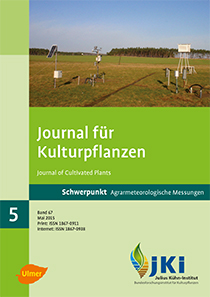Trail field Dahnsdorf – 15 years of agrometeorological measurements Part 3: Precipitation
Keywords:
Drought, normal value, precipitation, trial fieldAbstract
The considered period (1998–2012) had an average of 608.8 mm precipitation per year at the trial field in Dahnsdorf. This was almost 100 mm (+19.5%) above the normal period 1961/90 at the reference measuring point Treuenbrietzen (509.2 mm). The annual totals varied widely between 392.4 mm (2003) and 786.7 mm (2007).
The average monthly totals alternated in the first half of the year compared to the long-term normal value, those of the second half of the year were consistently above the comparison value.
The individual monthly totals varied widely. They ranged between 0.6 mm (April 2007) and 191.8 mm (August 2002).
The average daily totals were strongly influenced by extreme values in individual years. In principle, a year shows two maxima (summer and winter) and two minima (spring and autumn).
About half of the days had no precipitation. Their number during a month varied between 43.2% (November) and 59.8% (September). Very high daily totals occurred primarily in the summer months. Four days had more than 50 mm. The maximum daily total was registered on 4th August 2002; on that day in one hour 41.6 mm (12:50 to 1:50 pm CET) and in ten minutes 23.6 mm (1:10 to 1:20 pm CET) precipitation was measured.
Over the years, the number of days with daily totals ≥ 2.0 mm increased, while the number of days without precipitation increased, too.
The longest dry period was 33 days (04th April to 06th May 2007); two further dry periods lasted more than 20 days.
DOI: 10.5073/JfK.2015.05.03, https://doi.org/10.5073/JfK.2015.05.03
Downloads
Published
Issue
Section
License
The content of the journal is licensed under the Creative Commons Attribution 4.0 License. Any user is free to share and adapt (remix, transform, build upon) the content as long as the original publication is attributed (authors, title, year, journal, issue, pages).
The copyright of the published work remains with the authors. The authors grant the Journal of Cultivated Plants, the Julius Kühn-Institut and the OpenAgrar repository the non-exclusive right to distribute and exploit the work.







